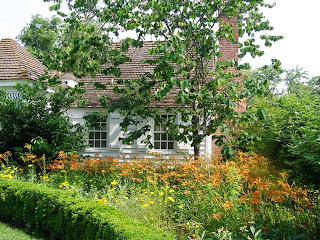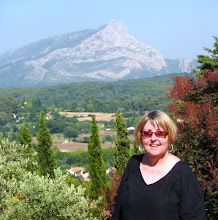The cemetery dates back to the days of the Spanish settlers in the area, but no graves are marked in a way that would indicate their age. In fact, many are not marked at all except by the stacks of rocks over them.
This arch over the entrance is an example of local Spanglish. It originally was in Spanish -- cementerio. Someone decided to translate it into English, but didn't quite translate it the whole way.

This is where we got our first taste of Mexican style graves. Nowadays, it's typical for many cemeteries in most of the US to have "perpetual care." It comes with the purchase of a plot. It didn't use to be that way & it is not often the case in southern AZ or Mexico. So a part of each Día de los Muertos is to clean up the grave & decorate it.
There are often abandoned graves with no one left to care for them. It isn't uncommon for unrelated people to do that. This cemetery had many people working in it cutting grass & cleaning up graves that were not in their own family.

These are some that had not been cleaned up yet when we were there.

These are some graves with rocks & no markers.

These have both rocks & markers.

Another common thing in these cemeteries is that people put their own markers, so there is a great deal of variety among them. Some are very fancy. Some are very plain. Sometimes they start small & become fancier as time goes by.
Many are home made, like this example. The cross is made of horseshoes.
Although this cemetery dates from the 18th century, the earliest marked graves I saw were from the 30's. This is one of them. The concrete stone may or may not be that old.

Something you see from time to time are graves with nichos (niches) usually with the Virgin of Guadalupe, Jesus or a saint.

Many graves have simple crosses of iron. Sometimes the names are readable, sometimes not. Sometimes there are no names.

Although newer, this was one of my favorites from the Tubac Cementery. I love the photo. Many inscriptions are in Spanish. This one means that Miguel is remembered by his wife & children.

Nogales, AZ
Things started to change when we got to Nogales, AZ. There were formal family plots, some large & some small. Many were walled with wrought iron, brick or both. Many were well-tended or being tended while we were there. Many were obviously abandoned.


Unlike Tubac, this was a very large cemetery. I tried to stay in the oldest section. The oldest grave I found there was for someone born in France. He died in 1886 at the age of 51.

One very simple family plot had this hand carved marker.

Some people replaced old iron crosses with tombstones as time & money allowed.

This unique new family plot was in the older section.

Down in a little valley below the main cemetery there were many newer, larger & fancier plots.

Nogales, Sonora
The cemetery in Nogales, SRA is called the Panteón Nacional. It sits in a valley & up 2 hills. One road runs right through it & another one cuts between 2 sections of it. There is also a private cemetery with many mausoleums above one of those sections.
Because November 2nd is a holiday, the place was packed with people, vendors, a carnival, etc. Going to the graves of loved ones on this day is not considered to be a sad thing. It's a time for reflection, of course, but also a time for family to get together & celebrate the lives of those who have died. People clean the graves, paint them, put flowers on them, have parties, eat, etc. I expected all that. I didn't expect the Mariachis that were playing for so many families.
Trout entering the main street between the primary sections of the Panteón.

Carnival to the left.

We passed right between these marigold, cockscomb & sugar cane vendors.


Many vendors were going through the Panteón selling food. This guy has cotton candy.

Mariachis at a family plot.

As we were walking down the road, we saw people mixing paint at their cars in buckets to carry to the graves. White was the color most often used, but these pictures illustrate other colors as well as the large number of people working on the graves. Plots are very crowded with no room between them, so it is impossible to not walk on someone's grave.




There weren't many enclosed tombs in the older sections of the Panteón, but this section did have some small ones.

In the private cemetery we saw some very elaborate ones.

We also saw some odd headstones.

In the public cemetery we saw some very humble graves. Some appeared to be abandoned. Most were not. We saw people repainting crosses & hand lettering the details about their loved ones right there.


Although neater than most, this is a pretty typical inscription for cross grave markers. The QEPD stands for Que en paz descanse -- May you rest in peace. The star for birth & the cross for death are typical shorthand for these crosses.

We saw many graves of children. It's common for people to encase them in wrought iron & fill them with balloons. This man was spray painting this child's grave. We couldn't stay long enough to see what else he was going to do.


Seeing the children's graves was heart-wrenching, but seeing graves for people who lived a very long time was also very touching.

I took this picture because of the name. Our next door neighbors are Parras, although Tony knows of no family members buried in the Panteón. Yolanda does have family there -- Huertas & Villas -- but I didn't know her family names until we got back, so I didn't notice any graves with those names on them.
We joked again about a Parr moving in next door to some Parras. Parr is a Scottish name. The two versions of the name could have gone either direction -- from Spain or Italy up to Scotland, losing the 2nd "a" or vice-versa adding it. I had never heard the Parra name until we moved here.
















 And he insisted I take a picture of the method used by the gates to stay closed.
And he insisted I take a picture of the method used by the gates to stay closed.



















































